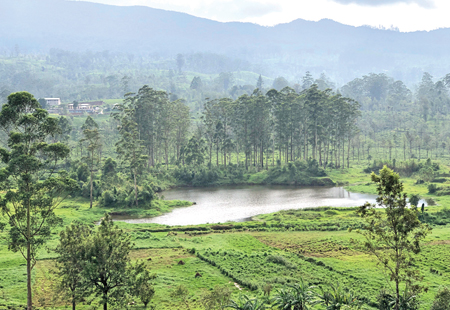 On February 23, the Sunday Observer published an exposé uncovering the environmental devastation and human toll linked to gem mining in Bogawantalawa. Following the publication of the article, Bogawantalawa Tea Estates PLC has now announced that it will cease all involvement in gem mining in the area. A company official said that, given the social and environmental repercussions of the project, the company cannot gamble with the lives of the local community. Safeguarding the plantations and by extension, the well-being of the people who depend on them he said remains its highest priority.
On February 23, the Sunday Observer published an exposé uncovering the environmental devastation and human toll linked to gem mining in Bogawantalawa. Following the publication of the article, Bogawantalawa Tea Estates PLC has now announced that it will cease all involvement in gem mining in the area. A company official said that, given the social and environmental repercussions of the project, the company cannot gamble with the lives of the local community. Safeguarding the plantations and by extension, the well-being of the people who depend on them he said remains its highest priority.
The groundwork for gem mining in Bogawantalawa was laid during the 2014 parliamentary election campaign, when former President Ranil Wickremesinghe visited the area and pledged to issue mining permits if elected. After the formation of the Good Governance Government in 2015, he made good on that promise, paving the way for mining operations to begin.
An agreement between the Bogawantalawa Tea Estates PLC and the National Gem and Jewellery Authority (NGJA) led to land in the Bogawantalawa–Chapelton Estate being allocated for gem extraction. Disturbingly, the designated sites were located in close proximity to Theresia School and the estate worker housing. Although Cabinet Paper No. 12/0007/527/001, approved on December 21, 2011, had formally earmarked the area for gem mining, large-scale excavation only began between 2016 and 2017.
Mining pits were dug near the Kehelgamu Oya, a vital tributary of the Mahaweli River, on grasslands long used by estate workers for farming and cattle grazing—disrupting both livelihoods and the local environment.
However as exposed in the previous Sunday Observer report, the project left seven abandoned gem pits in Bogawantalawa spanning a total area of 39,333 square metres, which has taken one life and continues to pose a serious risk to the local community.
The local authorities have repeatedly warned that the open pits pose a significant risk of drowning, especially for children. The area Medical Officer of Health’s (MOH) office has also raised concerns that the stagnant water in these pits could serve as breeding grounds for mosquitoes, heightening the risk of dengue and other deadly diseases.
No more mining
But following recent revelations about the project’s social and environmental impact, a meeting was held at the company’s head office in Colombo to assess its current status. During the discussion, senior officials voiced strong opposition to the continuation of gem mining activities in the area.”
The crucial meeting was attended by Bogawantalawa Tea Plantations PLC Director of Low Country Operations Dr Thusitha Bandara, Executive Director Lalith Munasinghe, Chief Executive Officer Feroz Majeed and the General Manager of the Kotiyagala Estate Nalinda de Alwis.
 During the discussion, it was disclosed that as part of the 2016 gem mining project, a mining site had been allocated to the Employers’ Federation of Ceylon (SLOT) with a profit-sharing arrangement. A portion of the revenue generated was also directed to the Divisional Secretariat.
During the discussion, it was disclosed that as part of the 2016 gem mining project, a mining site had been allocated to the Employers’ Federation of Ceylon (SLOT) with a profit-sharing arrangement. A portion of the revenue generated was also directed to the Divisional Secretariat.
The designated land was divided into 60 plots, with permission granted to mine in seven of them. However, excavation was completed at only three sites within the project’s timeframe, while work at the remaining four sites could not proceed.
The excavation activities were expected to be closely monitored by a team of officials from the Central Environmental Authority, Geological Survey and Mines Bureau, Natural Resources Management Centre (NRMC), the local Pradeshiya Sabha, and the Divisional Secretariat. Additionally, officials from the National Gem and Jewellery Authority were also present to oversee the operations.
Despite claims by researchers that gem extraction was carried out not only through vertical shafts but also through horizontal tunnels, company officials denied this allegation. “No illegal vertical excavations were carried out in the gem excavations. If they were, it would mean that there were shortcomings in the monitoring activities,” they noted.
Company officials said that a sudden and severe flood in 2016/2017 had completely submerged the areas where gem excavation had taken place. By then, the approved mining period had already ended, leaving behind abandoned, water-filled pits.
“As a plantation company, we did not grant permission for further gem mining in the Chapelton area,” an official noted. “Many of our estate workers had joined the mining activities, which caused a severe labour shortage on the plantations. Additionally, the arrival of gem miners from other districts created social tensions, as they were staying overnight in residential areas, causing unrest among local communities.”
Reputation over gains
Given these concerns, the company had decided against allowing further mining on its lands.
Officials also highlighted the need for environmental remediation, saying that the excavated pits must be properly closed. “If we are expected to close the three pits dug under our supervision, then the National Gem and Jewellery Authority should ensure that all 57 pits excavated across the area are also filled. The closure process must be comprehensive, as our ability to restore the land depends on the collective rehabilitation of the site,” the official added.
Despite repeated pressure and multiple rounds of negotiations, Bogawantalawa Tea Estates PLC has firmly refused to allow gem mining to resume on its lands.
Company officials said that the National Gem and Jewellery Authority (NGJA) has expressed interest in reviving gem excavations in the area, but the plantation company remains steadfast in its opposition.
“We were subjected to various forms of pressure to reconsider our decision, but we have made it clear we will not permit further gem mining activities,” an official asserted.
They explained that at the start of the previous mining operations, deposits were collected from licensees specifically to fund the restoration and closure of the pits after excavation. “The NGJA is responsible for utilising those funds to close the pits. If that is done, we are prepared to close the few remaining pits under our care. However, this must be part of a broader site-wide restoration effort,” the official emphasized.
The company reiterated that the consequences of mining in the area are both environmental and social. “We cannot risk the lives and livelihoods of the people. Even if we agreed to mine again, the activity would only last two years — but these plantations must be managed for centuries to come. Without plantations, the community cannot survive.”
Officials also questioned the NGJA’s claim of lacking funds to restore the damaged lands. “If the deposits were collected to rehabilitate the mining sites, what happened to that money? This is a matter that should be investigated by COPE or the Auditor General’s Department.”
“Bogawantalawa Plantations is a sustainable company. We cannot compromise our environmental and social responsibilities or the long standing reputation of our brand by engaging in activities that jeopardize our future,” the official said.
Sustainable solutions
The company has now proposed an alternative solution if the National Gem and Jewellery Authority (NGJA) lacks the funds to close the hazardous pits.
“Given that the excavation sites are now naturally submerged in water, we suggest a more sustainable approach: rainwater harvesting. This initiative could not only provide water to the Keselgamu Oya but also enhance the region’s water resources for local communities. Additionally, it holds the potential to attract tourists, benefiting the economy,” a company official noted.
According to him in particular, the waterlogged areas could be utilized for breeding the country’s national aquatic species. “By promoting inland fishing, this project could significantly improve the local population’s access to protein,” he added.
He said if the government is open to this proposal in principle, the Bogawantalawa Tea Plantation PLC is ready to offer full cooperation. Rather than investing large sums of money to close the pits, the government could consider this alternative, which would generate both environmental and economic benefits through tourism, he noted.
The company reiterated that it has not violated any agreement with the NGJA. “There are only two paths forward, either the NGJA takes responsibility for closing the pits, or we proceed with a project that leverages the site’s potential to attract tourists.”









